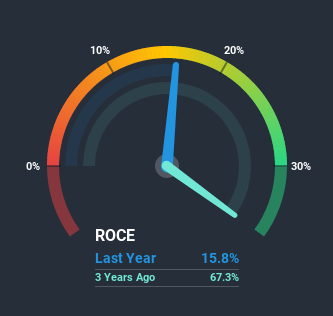Can Dwarikesh Sugar Industries (NSE:DWARKESH) Continue To Grow Its Returns On Capital?

What trends should we look for it we want to identify stocks that can multiply in value over the long term? Firstly, we'd want to identify a growing return on capital employed (ROCE) and then alongside that, an ever-increasing base of capital employed. Basically this means that a company has profitable initiatives that it can continue to reinvest in, which is a trait of a compounding machine. So when we looked at Dwarikesh Sugar Industries (NSE:DWARKESH) and its trend of ROCE, we really liked what we saw.
Return On Capital Employed (ROCE): What is it?
For those that aren't sure what ROCE is, it measures the amount of pre-tax profits a company can generate from the capital employed in its business. Analysts use this formula to calculate it for Dwarikesh Sugar Industries:
Return on Capital Employed = Earnings Before Interest and Tax (EBIT) ÷ (Total Assets - Current Liabilities)
0.16 = ₹1.1b ÷ (₹16b - ₹9.1b) (Based on the trailing twelve months to June 2020).
So, Dwarikesh Sugar Industries has an ROCE of 16%. On its own, that's a standard return, however it's much better than the 12% generated by the Food industry.
See our latest analysis for Dwarikesh Sugar Industries

While the past is not representative of the future, it can be helpful to know how a company has performed historically, which is why we have this chart above. If you'd like to look at how Dwarikesh Sugar Industries has performed in the past in other metrics, you can view this free graph of past earnings, revenue and cash flow.
The Trend Of ROCE
We're delighted to see that Dwarikesh Sugar Industries is reaping rewards from its investments and is now generating some pre-tax profits. About five years ago the company was generating losses but things have turned around because it's now earning 16% on its capital. Not only that, but the company is utilizing 128% more capital than before, but that's to be expected from a company trying to break into profitability. This can tell us that the company has plenty of reinvestment opportunities that are able to generate higher returns.
In another part of our analysis, we noticed that the company's ratio of current liabilities to total assets decreased to 56%, which broadly means the business is relying less on its suppliers or short-term creditors to fund its operations. This tells us that Dwarikesh Sugar Industries has grown its returns without a reliance on increasing their current liabilities, which we're very happy with. However, current liabilities are still at a pretty high level, so just be aware that this can bring with it some risks.The Bottom Line
Long story short, we're delighted to see that Dwarikesh Sugar Industries' reinvestment activities have paid off and the company is now profitable. And a remarkable 1,141% total return over the last five years tells us that investors are expecting more good things to come in the future. With that being said, we still think the promising fundamentals mean the company deserves some further due diligence.
One more thing: We've identified 5 warning signs with Dwarikesh Sugar Industries (at least 1 which can't be ignored) , and understanding these would certainly be useful.
While Dwarikesh Sugar Industries may not currently earn the highest returns, we've compiled a list of companies that currently earn more than 25% return on equity. Check out this free list here.
If you decide to trade Dwarikesh Sugar Industries, use the lowest-cost* platform that is rated #1 Overall by Barron’s, Interactive Brokers. Trade stocks, options, futures, forex, bonds and funds on 135 markets, all from a single integrated account. Promoted
New: Manage All Your Stock Portfolios in One Place
We've created the ultimate portfolio companion for stock investors, and it's free.
• Connect an unlimited number of Portfolios and see your total in one currency
• Be alerted to new Warning Signs or Risks via email or mobile
• Track the Fair Value of your stocks
This article by Simply Wall St is general in nature. It does not constitute a recommendation to buy or sell any stock, and does not take account of your objectives, or your financial situation. We aim to bring you long-term focused analysis driven by fundamental data. Note that our analysis may not factor in the latest price-sensitive company announcements or qualitative material. Simply Wall St has no position in any stocks mentioned.
*Interactive Brokers Rated Lowest Cost Broker by StockBrokers.com Annual Online Review 2020
Have feedback on this article? Concerned about the content? Get in touch with us directly. Alternatively, email editorial-team@simplywallst.com.
About NSEI:DWARKESH
Dwarikesh Sugar Industries
Engages in the manufacture and sale of sugar and ethanol in India and internationally.
Excellent balance sheet with reasonable growth potential.


